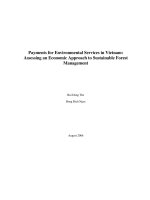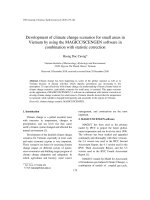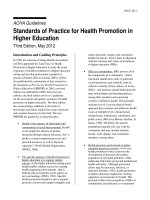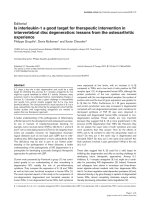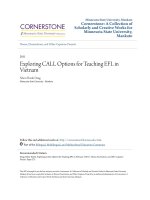Unit 14 Responsible Tourism Good Practice For Craft Villages In Vietnam
Bạn đang xem bản rút gọn của tài liệu. Xem và tải ngay bản đầy đủ của tài liệu tại đây (7.48 MB, 138 trang )
UNIT 14.RESPONSIBLE TOURISM GOOD PRACTICE
FOR CRAFT VILLAGES IN VIETNAM
Picture source:
/>
Unit outline
Objectives
By the end of this unit, participants will be able to:
•
Understand the positive and negative economic, environmental and social impacts of craft villages in
Vietnam and the benefits of responsible tourism
•
•
Explain the importance of developing products for markets and marketing them responsibly and ways to
2.
Explain the principles and practices in ensuring product quality, innovation and competitiveness to
3.
Explain issues of waste and pollution management in craft villages and steps to minimise negative
impacts
•
1.
do so
ensure commercial viability
•
Topics
Explain how to enhance participation and tourism destination attractiveness through craft village cooperation and co-ordination and development mechanisms
4.
5.
6.
Overview of Craft Villages and tourism in
Vietnam
Developing product-market links & marketing
responsibly
Ensuring product quality, innovation &
competitiveness
Managing waste & pollution
Effective co-operation & co-ordination
Responsible craft village destination
development
RESPONSIBLE TOURISM GOOD PRACTICE FOR CRAFT VILLAGES IN VIETNAM
TOPIC 1. OVERVIEW OF CRAFT
VILLAGES AND TOURISM IN VIETNAM
Picture source:
/>
Craft villages in Vietnam
•
> 30 % of households participating in craft
activities
•
•
•
Legally operate for at least 2 years
2 types - traditional and new craft villages
2017 craft villages estimated in 2007
Source: Mahanty, S, Dang, T & Hai, P. 2012, ‘Crafting sustainability: managing water pollution in Viet Nam’s craft villages,’ Development Policy Centre
Discussion Paper 20, Crawford School of Public Policy, The Australian National University, Canberra, Australia
Vietnam’s 12 categories of handicraft products
2.
Identify the handicrafts!
1.
4.
3.
Picture sources:
/>
Vietnam’s 12 categories of handicraft products
Identify the handicrafts!
6.
5.
7.
8.
Picture sources:
/>%20da%201.jpg
Vietnam’s 12 categories of handicraft products
Identify the handicrafts!
9.
10.
12. Others
11.
Picture sources:
/>
The importance of craft villages…
…to the nation
•
•
…to the community
Addresses rural poverty & helps counter ruralurban income gaps and migration
•
Fosters rural industrialisation and modernisation
•
•
& increases national and local budgets
Provides jobs and income during off-crop
seasons
Improves quality of life for local people
Enables the continued expression of artforms
Did you know….?
Craft villages generate jobs for 1.5 million people, of
which 60% are women, with most jobs located in rural
areas where employment is needed most
Vietnam’s handicrafts are exported to > 100
nations and generate export revenue of about
US$ 2.8 billion
Source: Cong, T. 2012, ‘Handicraft sector told to refresh itself’, TalkVietnam, Available [online]: www.talkvietnam.com/2012/10/handicraft-sector-told-to-refresh-itself/, Accessed:
14/08/2013
Crafts foster employment for the poor
•
•
•
•
Crafts use accessible
skills and resources
Crafts can support
other sources of
income
Crafts can fill
employment gaps
Crafts are accessible to people with limited formal education
Picture source:
/>
Crafts increase income for the poor
•
•
•
Crafts are based on
traditional skills
Other sources of income
can be limited
It is estimated craft
workers have an income
60% higher than the average income of other rural people
Crafts help preserve cultural heritage
•
•
•
Crafts are based upon
traditional forms of art
Commercial craft
production helps preserve
cultural heritage
Crafts help create national
pride and inspiration
Picture source:
/>
Crafts and craft villages create good consumer products and destinations
•
•
•
Crafts act as mementos
or souvenirs that connect
people to a place
Craft villages provide
enriching cultural learning
experiences for tourists
Craft villages create
opportunities for other
businesses to develop and improve local infrastructure and services
Picture source:
/>
Tourists want souvenirs that
Tourists want souvenirs that
give a physical reminder of a
give a physical reminder of a
place, people or experience
place, people or experience
HANDICRAFT
Handicrafts use a special mix of design,
Handicrafts use a special mix of design,
materials and production making them
materials and production making them
unique to a people and place
unique to a people and place
Why handicrafts are the ultimate souvenirs!
Crafts can help foster social cohesion
•
•
Craft skills can be passed
through families and
communities over
generations
Competition can help
create greater cohesion
amongst craft families and
communities
Picture source:
/>
The evolution of the handicrafts sector in Sapa
Before 1994
•
•
Unknown
Few villagers maintain these
1995 - 2000
•
•
Start engaging in tourism industry
More villagers involved
After 2000
•
•
traditional skills
Crafts develop strongly
More than 10 villages involved in
making handicrafts
•
•
Handicrafts exported
Villages begin attracting tourists
Picture source:
/>
Major challenges of the crafts sector
in sustainability 1/3
Limited
professional
development
Loss of
authenticity
Overreliance
on tourism
Picture sources:
Pixabay, />
Major challenges of the crafts sector
in sustainability 2/3
limited
MINE
!
design rights
and benefits
YOURS
Threats of sector
stagnation
waste and
pollution
Picture sources:
Pixabay, />
Major challenges of the crafts sector
in sustainability 3/3
commodification
of culture
Depletion
of natural resources
Others??
Picture source:
Pixabay, www.pixabay.com
Adopting a responsible tourism approach to improve craft village sustainability
Responsible tourism balances the needs of the consumer, supplier, community and environment
Minimises negative economic
Minimises
negative
economic
social
& environmental
social & environmental
impacts
impacts
Creates greater economic
Creates
greater
benefits
foreconomic
local people
benefits for local people
Promotes greater local
Helps conserve natural and
Promotesparticipation
greater local
Helps conserve
and
culturalnatural
resources
participation
cultural resources
Creates more attractive and
Creates
more attractive
commercially
viable and
products
commercially
products
(andviable
destinations)
(and destinations)
Application of responsible tourism
in craft villages
Topic 2 & 3
Topic 4
Topic 5
Developing
Developing product-market
product-market links
links &
& marketing
marketing
responsibly
responsibly
Ensuring
Ensuring product
product quality,
quality, innovation
innovation &
&
competitiveness
competitiveness
Topic 6
Managing
Managing craft
craft
waste
waste &
& pollution
pollution
Effective
Effective co-operation
co-operation &
& cocoordination
ordination
Responsible
Responsible craft
craft village
village
destination
destination development
development
Topic 7
Benefits of adopting a responsible tourism approach in craft villages
Greater ownership &
Enhanced
Enhancedexperiences
experiencesfor
for
accountability
tourists
tourists&&consumer
consumer
Maintenance of cultural
integrity and pride
Empowerment of local
residents
Enhanced
Enhancedappreciation
appreciationof
of
contribution
contributionof
oftourism
tourismto
to
cultural
culturalpreservation
preservation
RESPONSIBLE TOURISM GOOD PRACTICE FOR CRAFT VILLAGES IN VIETNAM
TOPIC 2. DEVELOPING PRODUCT-MARKET LINKS & MARKETING RESPONSIBLY
Picture source:
/>
What do we mean by product-market links?
•
•
•
•
•
A product is the finished craft that is available for sale
to consumers
Vietnam has 12 craft products groups
MARKET
Markets are the end consumers who buy the products
Markets can be domestic
or international (export)
Markets can be further
defined into market segments
PRODUCTS
Picture source:
Pixabay, www.pixabay.com
Why do we need to match products to markets?
•
•
Not all markets may be interested in the same product/s
•
•
Consumers have different budgets
FORM
Consumers have different needs in product design, form,
and function
Expectations / requirements of product quality can also
vary
FUNCT
ION
PRICE
DESIGN
QUAL
ITY
Picture source:
Pixabay, www.pixabay.com

